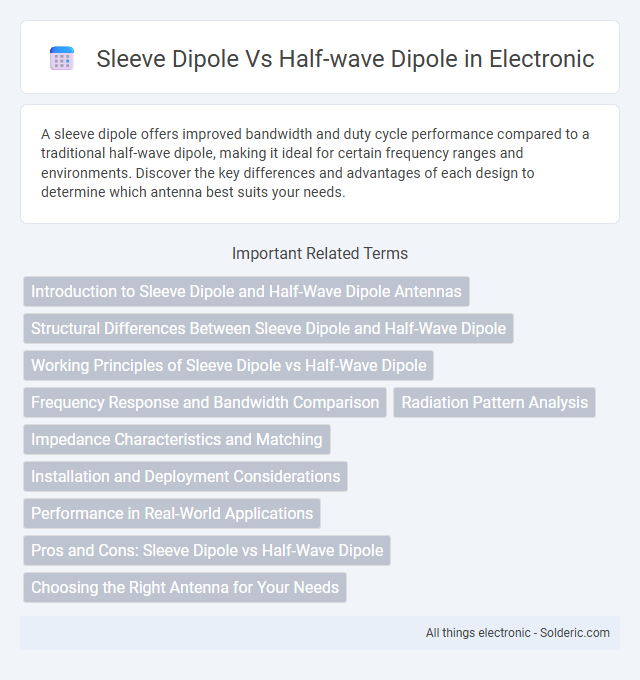A sleeve dipole offers improved bandwidth and duty cycle performance compared to a traditional half-wave dipole, making it ideal for certain frequency ranges and environments. Discover the key differences and advantages of each design to determine which antenna best suits your needs.
Comparison Table
| Feature | Sleeve Dipole | Half-Wave Dipole |
|---|---|---|
| Structure | Two-conductor design with outer sleeve acting as a radiator | Simple two-wire conductor, each side a quarter wavelength |
| Length | Typically quarter wavelength plus sleeve length | Half wavelength overall |
| Impedance | Approximately 300 O | Approximately 73 O |
| Bandwidth | Narrow to moderate bandwidth | Moderate bandwidth |
| Polarization | Horizontal or vertical | Primarily horizontal |
| Use Cases | Compact designs, VHF applications, impedance matching | General HF applications, amateur radio, broadcast |
| Advantages | Reduced size, balanced feed, simple impedance transformation | Simple construction, efficient radiation, easy tuning |
| Disadvantages | More complex to build, narrower bandwidth | Larger size, lower impedance may require matching |
Introduction to Sleeve Dipole and Half-Wave Dipole Antennas
Sleeve dipole antennas feature a coaxial sleeve acting as a balun, enhancing impedance matching and reducing feedline radiation, unlike traditional half-wave dipole antennas that rely on simple conductive elements resonating at half the wavelength. Your choice depends on application requirements, with sleeve dipoles offering broader bandwidth and better signal purity, while half-wave dipoles provide simplicity and ease of construction. Both serve as fundamental antenna types widely used in VHF and UHF communications.
Structural Differences Between Sleeve Dipole and Half-Wave Dipole
A sleeve dipole consists of a half-wave radiator paired with a quarter-wave sleeve acting as a shield or counterpoise, creating a coaxial structure that improves impedance matching and bandwidth. In contrast, a half-wave dipole features two equal-length conductive elements oriented end-to-end, forming a simple linear antenna without additional shielding. Understanding these structural differences can help you select the appropriate antenna design for optimized performance in your radio or communication system.
Working Principles of Sleeve Dipole vs Half-Wave Dipole
The sleeve dipole operates by combining a coaxial sleeve with the radiating element, creating a balanced antenna with improved impedance matching by using the sleeve as a shield and radiator. In contrast, the half-wave dipole consists of two quarter-wavelength arms resonating at the target frequency, relying on its length and geometry to achieve resonance with minimal external components. Your choice between these depends on the desired bandwidth, impedance characteristics, and installation constraints inherent in their working principles.
Frequency Response and Bandwidth Comparison
Sleeve dipoles exhibit a wider bandwidth and more stable frequency response due to their coaxial sleeve structure, making them suitable for broadband applications. Half-wave dipoles typically offer narrower bandwidths with sharper resonance peaks, which can result in more frequency sensitivity and less tolerance for frequency shifts. The sleeve dipole's impedance remains relatively constant over a broader frequency range, enhancing performance in multi-frequency or wideband scenarios compared to the half-wave dipole.
Radiation Pattern Analysis
The radiation pattern of a sleeve dipole is characterized by a more omnidirectional distribution in the horizontal plane, making it suitable for applications requiring uniform coverage. In contrast, the half-wave dipole displays a figure-eight radiation pattern with nulls perpendicular to the antenna axis, concentrating energy in two opposite directions. Understanding these differences helps you optimize antenna selection based on desired coverage and signal propagation needs.
Impedance Characteristics and Matching
Sleeve dipoles exhibit a unique impedance characteristic, typically around 50 to 75 ohms, which offers better inherent matching to standard coaxial cables compared to traditional half-wave dipoles with an impedance near 73 ohms. The sleeve dipole's balanced feed and protective sleeve structure reduce reactive components, resulting in a more stable impedance over a wider frequency range, enhancing antenna system performance. This impedance consistency simplifies antenna matching networks, minimizing signal reflection and maximizing power transfer in RF applications.
Installation and Deployment Considerations
Sleeve dipoles offer simplified installation due to their integrated balun, reducing the need for additional components and minimizing signal interference during deployment. Half-wave dipoles require careful matching and often necessitate external baluns or transformers, which can complicate the setup and increase installation time. Your choice depends on the deployment environment, with sleeve dipoles providing easier handling in limited space or quick installations.
Performance in Real-World Applications
Sleeve dipole antennas generally offer improved impedance matching and broader bandwidth compared to traditional half-wave dipoles, enhancing performance in varied environments. Your choice between these antennas can significantly impact signal stability and range, especially in complex urban or indoor settings where multipath interference is common. Real-world tests often show sleeve dipoles maintaining consistent gain and reduced signal distortion, making them preferable for reliable communication applications.
Pros and Cons: Sleeve Dipole vs Half-Wave Dipole
A sleeve dipole offers improved impedance matching and a narrower bandwidth compared to a half-wave dipole, making it ideal for applications requiring specific frequency tuning. Your choice of a half-wave dipole provides broader bandwidth and simplicity of construction but may require additional tuning or balun components to achieve optimal performance. While the sleeve dipole minimizes common-mode currents and offers better noise rejection, the half-wave dipole remains a versatile and widely used antenna with fewer manufacturing complexities.
Choosing the Right Antenna for Your Needs
A sleeve dipole offers enhanced bandwidth and improved impedance matching, making it ideal for applications requiring a wide frequency range and consistent performance. Half-wave dipoles are simpler, easier to construct, and perform well for narrowband signals, suitable when specific frequency targeting and straightforward installation are priorities. Your choice depends on balancing frequency requirements, installation complexity, and desired signal stability to achieve optimal antenna efficiency.
sleeve dipole vs half-wave dipole Infographic

 solderic.com
solderic.com